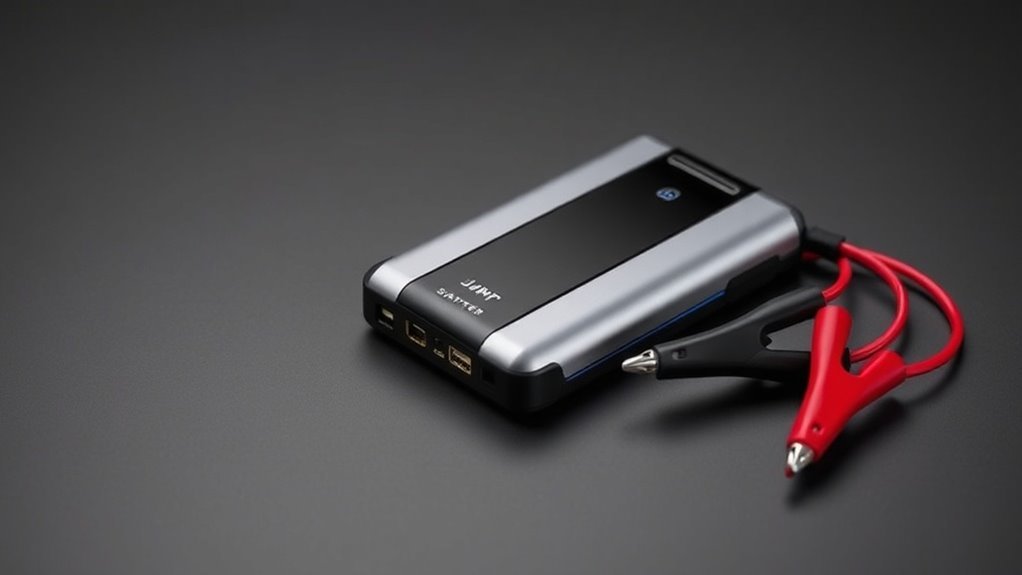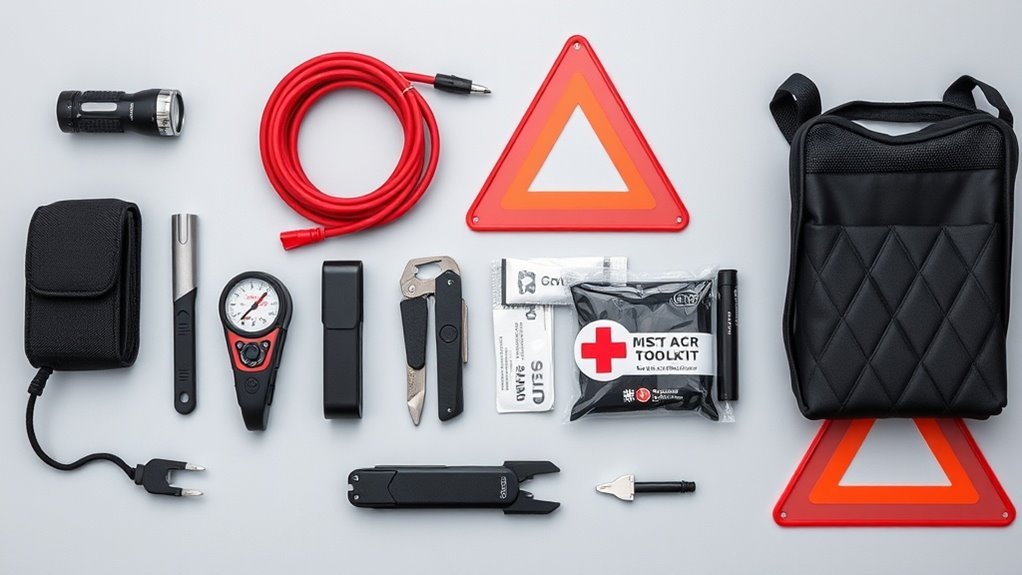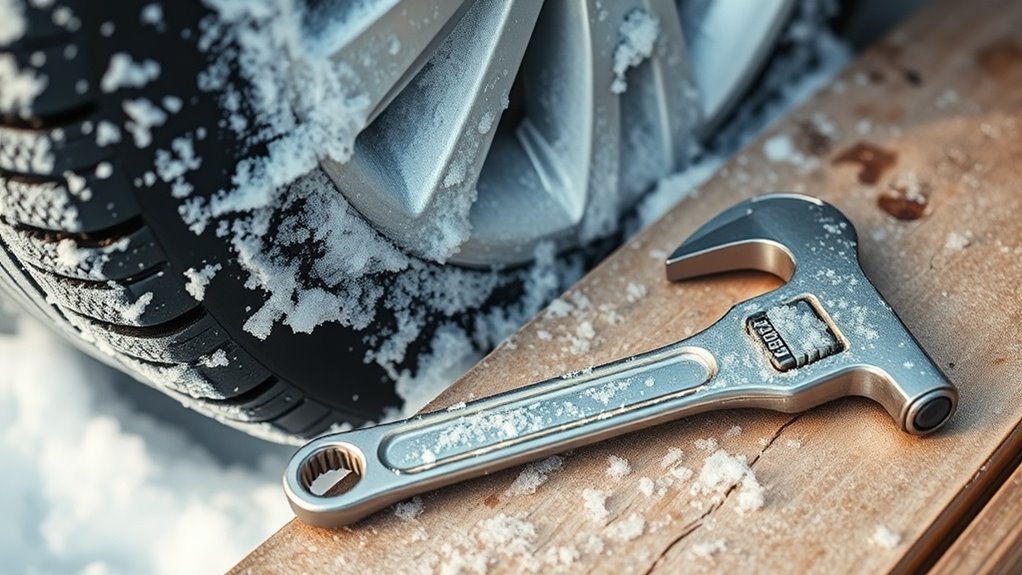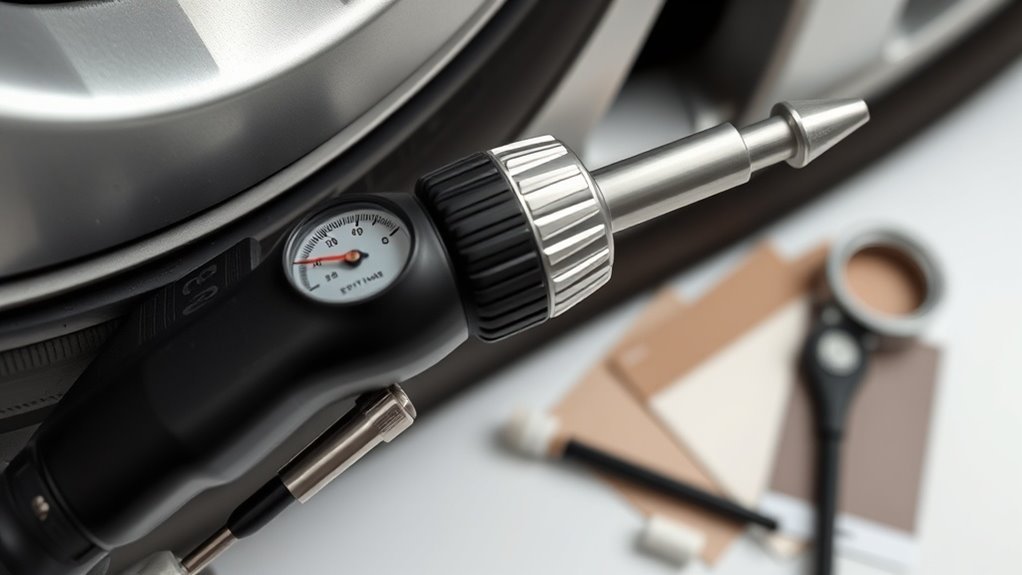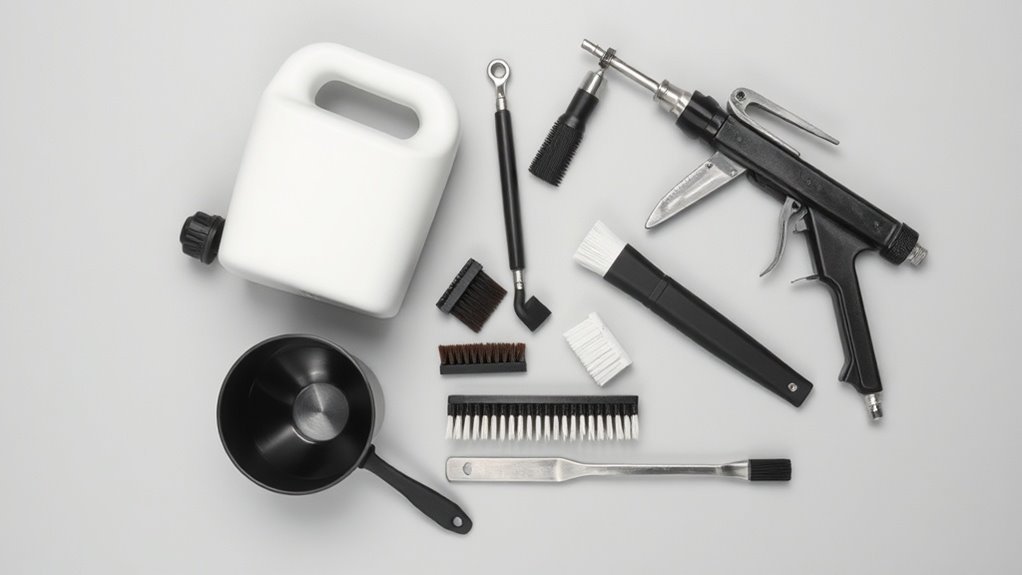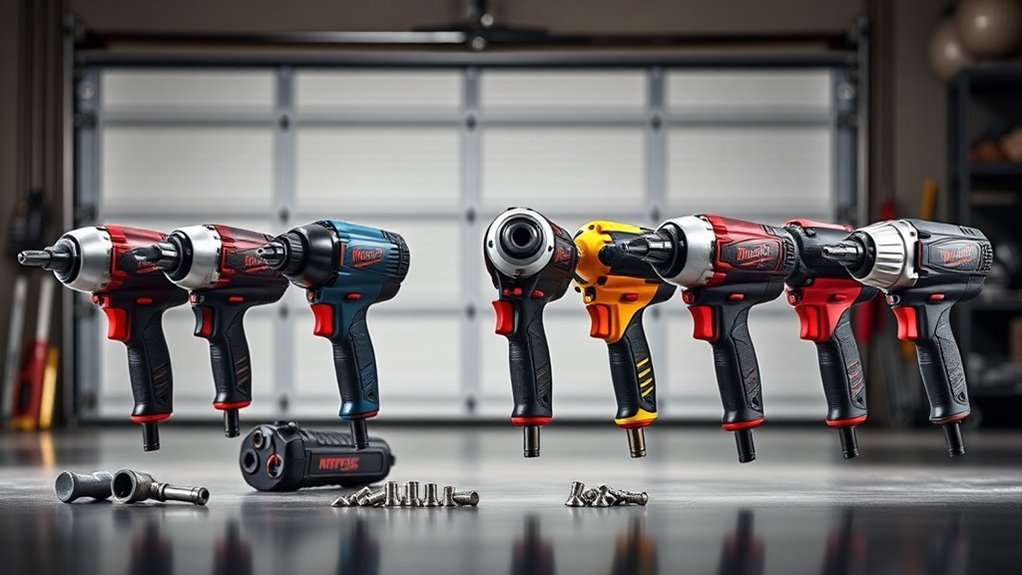Tire Pressure Basics and Why Inflators Are Essential
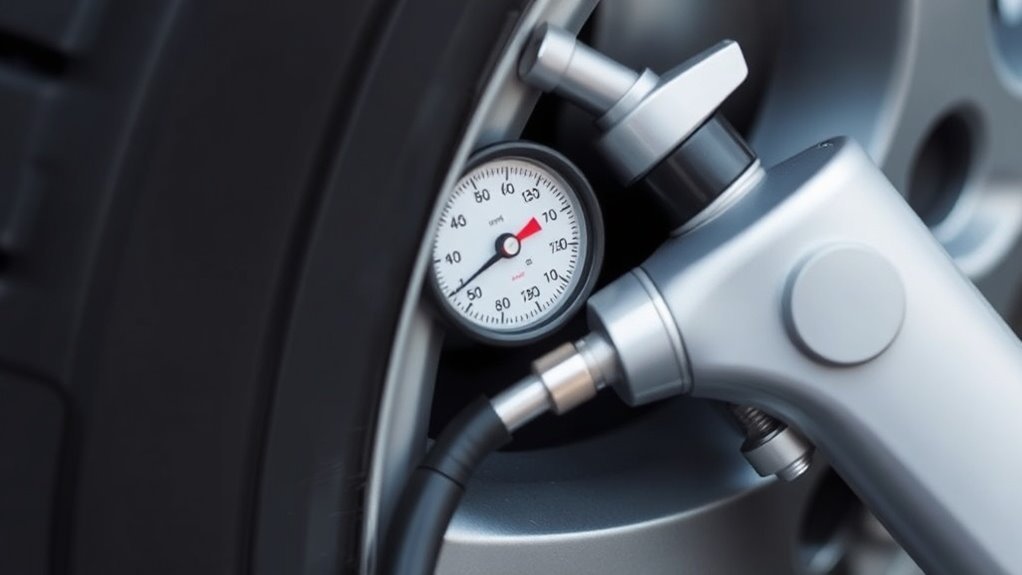
Proper tire pressure is vital for your vehicle’s performance, safety, and fuel efficiency. It affects handling and helps prevent blowouts. Under-inflation can lead to premature tire wear and increased energy costs, while over-inflation raises the risk of tire failure. A reliable tire inflator makes it easy to maintain the right pressure, ensuring safe driving. With the right tools and knowledge, you can keep your tires in great shape and enhance your driving experience. Explore more about this essential topic.
Key Takeaways
- Proper tire pressure ensures vehicle performance, safety, fuel efficiency, and comfort during drives.
- Under-inflation can lead to poor handling, increased tire wear, and reduced fuel economy.
- Over-inflation raises the risk of blowouts and causes uneven tire tread wear and loss of comfort.
- Regularly checking tire pressure with a gauge helps maintain optimal inflation levels and ensures safety.
- Tire inflators provide convenience for quick inflation, enhance fuel efficiency, and allow assistance to others in need.
Understanding Tire Pressure
[Tire pressure plays an essential role in vehicle performance and safety.
You mightn’t realize how much it affects handling, fuel efficiency, and comfort while driving. When your tires are properly inflated, they’ll grip the road better, providing you with a smoother ride and improved control. Low tire pressure can cause excessive wear and tear, leading to costly replacements.
Tire pressure significantly affects your vehicle’s handling, fuel efficiency, and driving comfort. Proper inflation ensures better grip and control.
On the other hand, over-inflated tires may result in a harsh ride and reduced contact with the road, compromising traction. Regularly checking your tire pressure is crucial.
You’ll typically find the recommended pressure on a sticker inside the driver’s door or in the owner’s manual. Keeping your tires at the right PSI not only extends their lifespan but also enhances your overall driving experience. Additionally, being aware of the flow rate of your inflator can help you inflate tires more efficiently, saving you time and ensuring proper maintenance.]
The Importance of Proper Tire Inflation
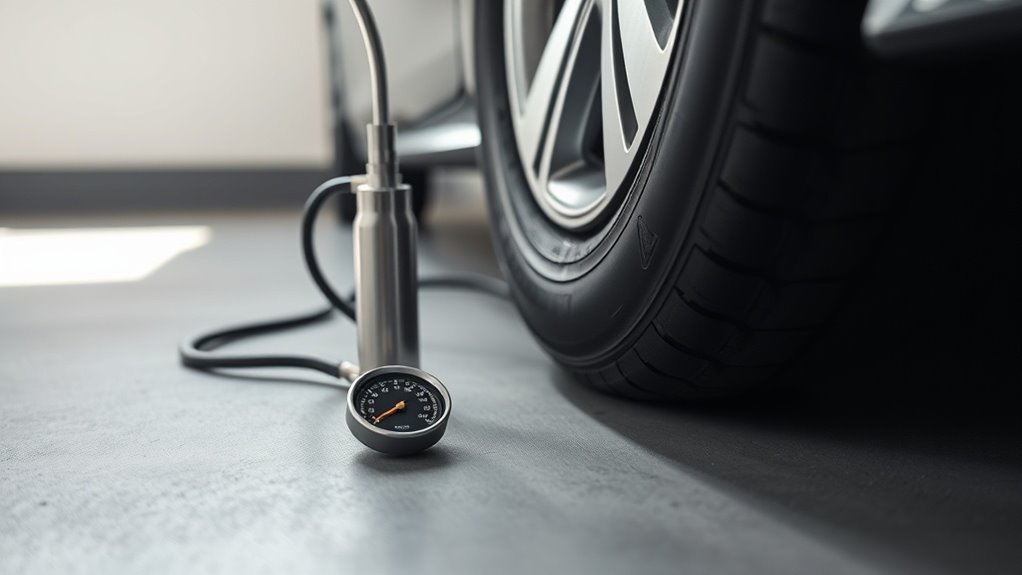
Keeping your tires properly inflated is essential for your safety and the vehicle’s performance.
When your tires are at the right pressure, you’ll not only enhance handling but also improve fuel efficiency.
Ignoring this simple task could lead to more wear and tear on your tires and higher gas expenses.
Safety and Performance
Proper tire inflation is essential for both your safety and your vehicle’s performance, as under-inflated tires can lead to reduced handling and increased risk of blowouts. When your tires aren’t properly inflated, you compromise not only the ride quality but also the stability and grip on the road.
Here are some key reasons why keeping your tires inflated is important:
- Enhanced handling: Well-inflated tires respond better to steering, improving maneuverability.
- Reduced blowout risk: Adequate pressure helps prevent overheating and tire failure.
- Better traction: Proper inflation maximizes the contact patch, ensuring improved traction on all surfaces.
Taking a few minutes to check your tire pressure can make a significant difference in your driving experience.
Stay safe and keep your vehicle performing at its best!
Fuel Efficiency Impact
Maintaining the right tire pressure can lead to a remarkable improvement in your vehicle’s fuel efficiency.
When your tires are properly inflated, they roll more smoothly, reducing rolling resistance and letting your engine work more efficiently. Conversely, under-inflated tires can cause extra drag, forcing your engine to burn more fuel—often, by up to 3% for every 1 psi drop in pressure.
You won’t just save on gas; you’ll also extend the life of your tires. Regularly checking tire pressure can help you stay informed and proactive about your vehicle’s performance.
Effects of Under-Inflation on Performance
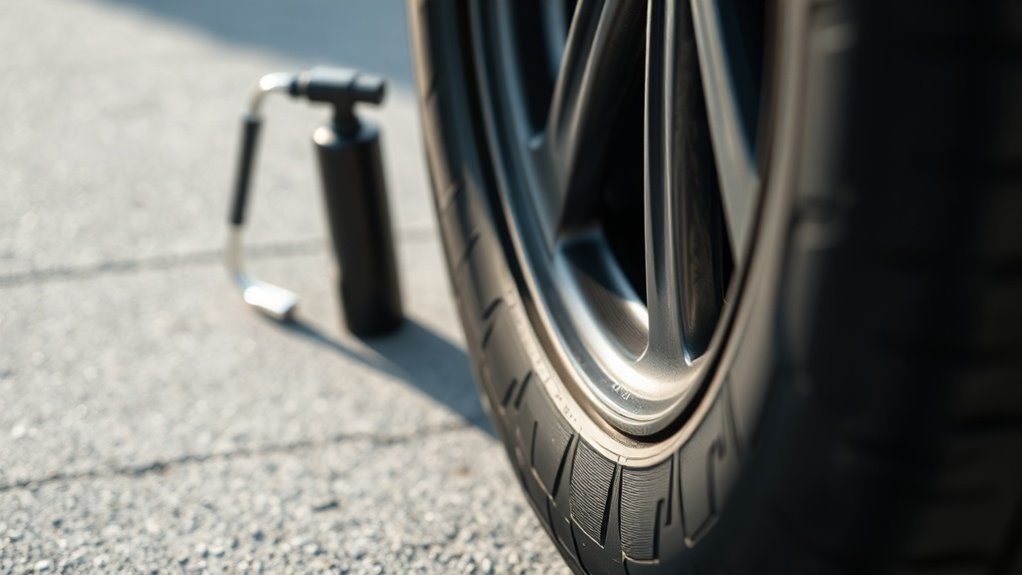
Under-inflation can, in particular, impact your vehicle’s performance, leading to a host of issues that affect both safety and efficiency.
When your tires don’t have the right pressure, you might face several challenges:
- Reduced Handling: Your vehicle may feel less responsive, making it harder to control during turns or emergency maneuvers.
- Increased Tire Wear: Under-inflated tires wear unevenly, which can shorten their lifespan and lead to expensive replacements.
- Poor Fuel Economy: You’ll find that under-inflation requires more energy for your vehicle to move, leading to decreased fuel efficiency.
Ensuring your tires are properly inflated not only enhances performance but also keeps you safer on the road.
Regular checks can save you hassle and money in the long run.
Dangers of Over-Inflation
Over-inflating your tires can lead to serious risks like blowouts, which can put you and others in danger on the road.
You might also notice uneven tread wear, causing you to replace tires more often.
Plus, your vehicle’s handling stability could be compromised, making it harder to control during your drive.
Tire Blowouts Risk
When tires are inflated beyond their recommended pressure, the risk of blowouts considerably increases, posing a serious danger to drivers. High pressure can lead to tire failure, especially during high-speed driving or in extreme temperatures.
It’s essential to regularly check your tire pressure and adjust it accordingly. Here’s why over-inflation is a concern:
- Reduced Flexibility: Over-inflated tires lose their ability to absorb shocks, making your ride less comfortable.
- Uneven Wear: Excess pressure can cause certain parts of the tire to wear out faster, compromising safety.
- Increased Heat: Higher pressure generates more heat, which raises the chance of a sudden blowout.
Keeping your tires correctly inflated is important for maintaining safety and performance on the road.
Uneven Tread Wear
While you might think a little extra air in your tires is harmless, it can lead to uneven tread wear that compromises your vehicle’s safety.
Over-inflated tires wear more in the center than on the edges. This can create a slick surface that offers less traction, especially in wet conditions. You may not notice the differences immediately, but over time, the tread can wear down faster, leading to reduced performance and increased chances of hydroplaning.
Plus, uneven wear means you’ll need to replace your tires sooner than expected, costing you money. Keeping your tires properly inflated is essential—not just for their longevity, but also for your peace of mind while driving.
Reduced Handling Stability
Improper tire pressure doesn’t just lead to uneven tread wear; it can also significantly impact your vehicle’s handling stability.
When your tires are over-inflated, they become rigid, reducing their grip on the road. This can make your vehicle feel skittish, especially during sharp turns or sudden maneuvers.
Here are some risks associated with reduced handling stability:
- Decreased Traction: With less tire surface in contact with the road, you’ll struggle for grip in wet or slippery conditions.
- Increased Skidding: High tire pressure can lead to a loss of control during emergency stops, potentially causing skids.
- Unpredictable Steering Control: Over-inflated tires can make your vehicle feel less responsive, hindering your ability to steer accurately.
Keep your tires properly inflated for a safer, more stable driving experience.
How to Check Tire Pressure
Checking your tire pressure is essential for safe driving and ideal vehicle performance. Start by gathering a reliable tire pressure gauge.
You’ll want to check your tires when they’re cold, ideally before you’ve driven more than a mile. Remove the valve cap from one tire, press the gauge onto the valve stem, and read the number.
If the pressure is too low, add air until it reaches the recommended level. If it’s too high, let some air out.
Don’t forget to repeat this for all your tires, including the spare! Once done, replace the valve caps securely.
Regularly checking your tire pressure helps prevent issues and can enhance fuel efficiency, keeping you safe on the road.
Recommended Tire Pressure Levels
Knowing how to check tire pressure is just the first step; understanding the recommended pressure levels is equally important. Each vehicle has its own specifications, typically found in the owner’s manual or on a sticker inside the driver’s door. Maintaining the right pressure guarantees peak performance and safety on the road.
Here’s what you should consider for recommended tire pressure levels:
- Vehicle Manufacturer’s Specs: Always refer to the specific guidelines provided by your vehicle’s manufacturer.
- Seasonal Changes: Pressure can fluctuate with temperature changes; check it regularly, especially during seasonal shifts.
- Load Conditions: If you’re carrying heavy loads, you might need to adjust the pressure according to the recommendations.
Keeping your tires properly inflated can enhance your driving experience considerably!
Benefits of Using a Tire Inflator
Using a tire inflator can save you time and hassle, especially when you’re in a pinch. Instead of making a trip to the gas station or waiting for roadside assistance, you can quickly inflate your tires right at home or on the go. This convenience means you’re less likely to experience flat tires while driving, which enhances your safety.
Having a tire inflator also helps you maintain ideal tire pressure, improving your vehicle’s fuel efficiency and extending tire life.
Plus, with a portable inflator, you can easily assist others, turning a potentially stressful situation into an opportunity to help a friend or fellow driver. Overall, investing in a tire inflator is a simple yet effective way to guarantee your tire care routine stays on track.
Types of Tire Inflators to Consider
When it comes to tire inflators, you’ll find a variety of options to suit your needs and preferences. Choosing the right type can simplify your life and keep your tires properly inflated.
Here are three popular types to contemplate:
- Portable Electric Inflators: Compact and easy to use, these plug into your car’s power outlet or have a rechargeable battery, making them great for emergencies.
- Manual Hand Pumps: Ideal for quick fixes and off-road situations, they require physical effort but are lightweight and don’t rely on electricity.
- Foot Pumps: These offer a good balance between portability and power, allowing you to inflate tires without a power source using your foot to operate the pump.
Each option has its own advantages, so pick what best fits your lifestyle!
Maintenance Tips for Your Tires and Inflator
Regular maintenance is essential for keeping your tires and inflator in top shape. Start by checking your tire pressure at least once a month and before long road trips.
Verify your inflator’s nozzle and hose are clean and undamaged; any dirt can interfere with air flow. Additionally, inspect your tires for wear and tear, looking for uneven tread or bulges.
Rotate your tires every 5,000 to 8,000 miles to promote even wear.
Don’t forget to store your inflator in a dry, accessible location to avoid damage. Finally, replace your inflator’s battery if it’s rechargeable, so you’re always ready to go.
Keeping these tips in mind will enhance your safety and prolong the life of your tires and equipment.
Questions
How Often Should I Check My Tire Pressure?
You should check your tire pressure at least once a month and before long trips. Temperature changes can affect pressure, so it’s essential to stay on top of it for safety and performance.
Can Tire Pressure Affect Fuel Economy?
Just like a balloon loses air, low tire pressure can deflate your fuel economy. If your tires aren’t properly inflated, you’ll end up using more gas, costing you extra money at the pump.
What Is the Ideal Tire Pressure for Winter?
The ideal tire pressure for winter usually ranges between 30 to 35 PSI, depending on your vehicle. Always check your owner’s manual for specifics, since proper pressure helps guarantee safety and stability on icy roads.
Does Temperature Affect Tire Pressure Readings?
Yes, temperature affects tire pressure readings. As temperatures drop, tire pressure decreases, and vice versa. It’s important to regularly check your tire pressure, especially during seasonal changes, to guarantee ideal performance and safety.
How Can I Prevent Tire Pressure Loss?
To prevent tire pressure loss, check your tires regularly, guarantee valve stems are secure, avoid potholes, and maintain proper tire rotation and alignment. Also, consider using sealants or tire pressure monitoring systems for added monitoring.
Conclusion
In summary, keeping your tires properly inflated is essential for both safety and performance. Did you know that nearly 1 in 4 cars have at least one under-inflated tire? By regularly checking your tire pressure and using a tire inflator, you can enhance fuel efficiency and extend tire life. So don’t overlook your tires—make maintenance a priority and enjoy the smooth ride ahead. With a little effort, you’ll hit the road with confidence!

